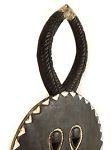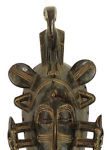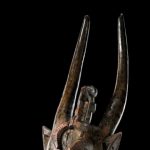My apologies for not posting sooner, however, both of the laptops to which I have access had terminal issues—one had the feared black screen of death, and needed a hard drive replacement, and the other (only 2 weeks old!) had OS problems and needed to be returned to factory settings after having the OS replaced. Reloading everything has been technical torture!!!
A good friend, knowing of my interest in African art, gave me a book on the Ivory Coast recently, Reflets de la Cote d’Ivoire, a collection of articles on all aspects of life in the Ivory Coast by Editor, Philippe Oberle. The only challenge to me was that the book is in French, and I have not used the language since high school…many centuries ago ;-), but I took up the challenge and decided to translate a selection (page 88) on masks for the blog. So here goes!
The word “masks” recalls all the richness, complexity and mystery of the African soul. The functions of African masks have no comparison to the masks of Europe, which are theatrical accessories or solely for amusement. H.B.Tobias, an Ivorian intellectual, states that it is not proper to confuse the term “masks” with “masked man”.
The African mask is properly both ancestral and divine. The man who wears one is only an instrument, for at his death, another will carry the mask. The mask holds the power, and is the intermediary between gods, ancestors, and man. It assumes a fundamental role in the structure and cohesion of the village institution. In central and western Ivory Coast, some masks function for public amusement.
Among the Senufo, from northern Ivory Coast, are masks which function in ceremonies for the Poro Society initiations, and which are made from sacred funerary wood; the Gpelihe mask, with its stylized human face; the frightening funeral mask, Korobla, with its impressive jaw, ornamented with mirrors and bristling with feathers. Certain figural masks are surmounted by a mammals head, a hornbill and a chameleon, symbolizing the hornbill bird found on the forehead of an ancestor, in order to introduce the chameleon’s intelligence to it.
Senufo ceremonies are generally forbidden to outsiders, though people can assist in the evening funerals at Korhogo with a selection of masks, but photos are prohibited.
Amongst the Baule, the zoomorphic Goli mask, is surrounded by fear and respect. One can question it when a suspicious death occurs in the village, offer it libations to coax it, or to thank it for a blessing.
The Zaouli is a dance mask of the Guro tribe. It represents the face of a young girl and is danced with grace and delicacy. It calls for volunteers from the public and it participates in receiving VIPs.
The western forest represents the area with the most excellent masks. Amongst the Guere and the Dan (Yacouba), each village possesses their unique masks. They function with diverse powers. They nearly all represent human faces but with various styles. The mask of wisdom (sagesse) is the depository of power and knowledge. It gives protection and blessings to the village. It forestalls calamities, rules over disputes, and renders justice. The Griot masks surround them and praise their greatness. The warrior mask assures defense of the village. Its expression is frightening. The gendarme (constable) mask assures order and discipline. Dance masks and singers animate the festivals. They carry cow bells and grelots (wading birds) on their feet. The Dan wading masks are of a type of black hood, and they move on stilts many meters tall.
The masks of the west are used in public for certain festivals, notably in April at Beoua (25 km from Guiglo), and Easter weekend at Deoule (14 km from Man). Beoua has accommodations for visitors who can partake fully in village life. A grand festival of masks takes place on occasion in Man.
Many thanks to the author for his diligent work preparing the information for the book. It is quite comprehensive.




Recent Comments